Talking with Michael Neff was refreshing. I didn’t know much about Suspended Forest before speaking with him, other than it being a popular event on my Facebook feed, so I didn’t know what to expect him to say. To be perfectly honest, from my initial glace I assumed it was going to be another installation about environmental degradation or social commentary on consumer culture. What I found surprised me; we began our conversation with the usual introductions and laying out of credentials but quickly found common ground discussing gentrification, a topic that almost derailed us from discussing his project. As the interview carried on, I heard him speak about Suspended Forest, the inspiration, his past works and artistic concerns, and anecdotes he had collected through working on this project and others, and I was honestly blown away. Here was a man who seemed so awestruck by his work; the way he discussed Suspended Forest seemed both shocking and exciting for him, with overall enthusiasm for how positively the public had taken to it.
Suspended Forest 2016 Installation at Knockdown Center from Michael Neff on Vimeo.
Suspended Forest is a project that, at its core, is about observation. Originally, it was staged under the BQE in Williamsburg in both 2012 and 2013 (which Art in Odd Places had discussed in a previous post), before moving to Knockdown Center in Queens this year after a three-year hiatus. For Michael, it began as a simple observation: seeing the drifts of Christmas trees that build up outside of buildings after the holiday seasons ends.
“When I first moved to New York I was living in Brooklyn and I was working in the city. That first year I remember that the kind of awestruck feeling that I had when after New Year’s you start to see those drifts of trees on the sidewalks in front of big buildings. You would see these stacks of trees. Having grown up [on] the west coast, the cities aren’t that dense there, in San Francisco it’s one of the more dense cities on the west coast and you still don’t see that, it just doesn’t happen in the same way and I was a little awestruck.”
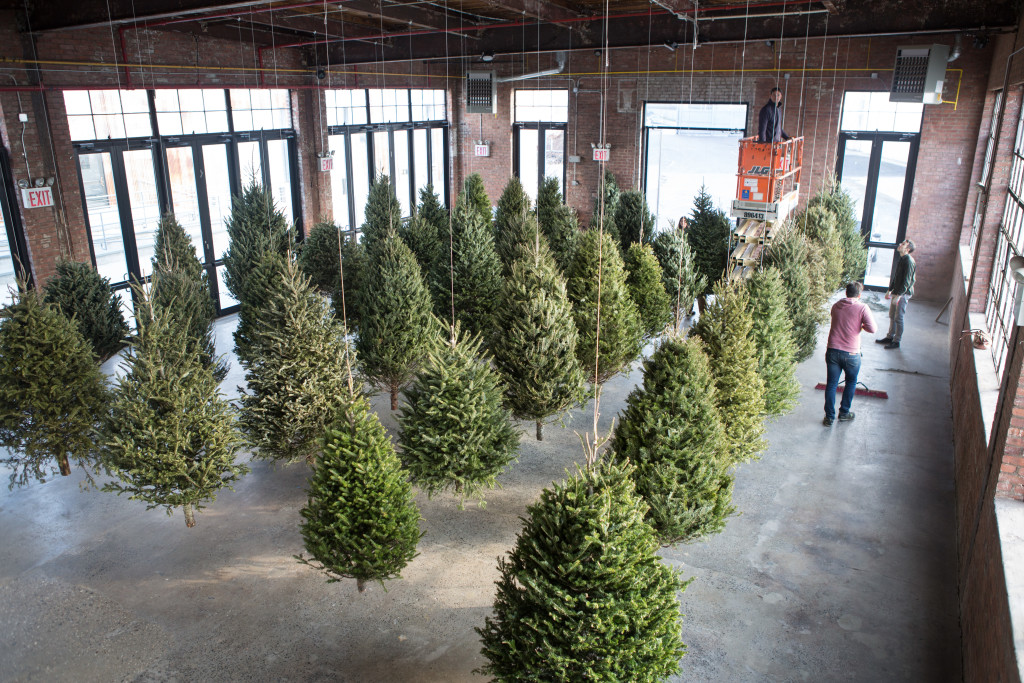
Suspended Forest 2016. Photo courtesy of the artist.
However, this initial observation only planted the seeds, as it took a couple of years for Suspended Forest to actually sprout.
“I have worked in various media and still do and a lot of my work is about paying attention, being attentive, and noticing. When I find things I think are interesting, pointing at them, sharing them with people. I actually in my work, kind of in every media I end up working in, almost sort of like hunting; in this case I found this thing I thought was interesting, the way that trees get consumed and disposed of in a really dense place. I saw it and recognized it and filed it away as interesting and what should I do with this? This is definitely material for something, material both conceptually and also physically.”
Some time passed and Michael eventually moved into Manhattan but the possibility of using Christmas trees as a material still lingered in his mind. Eventually he decided he was going to do something with it, but now the question turned to where? It was only after he moved back to Williamsburg he found the answer, and just like how observant inclinations found him his material, so too did it find him his space.
“When I move back, I ran into this space under the BQE, which I had seen many times before, especially having lived in Williamsburg, it’s under the BQE, along Metropolitan [Avenue], so if you’re getting off at Lorimer [stop] and you’re going to the Bedford [Avenue] side, or somewhere over toward the Bedford side, the way that you walk is right under the BQE, right past this big fenced off, open space. I saw this space and I was like, I think this is it, it’s unused, it was almost like a stage, and there was all this foot traffic and car traffic. I still wasn’t sure what I wanted to do; I didn’t when I saw the trees for the first time go oh I know, I want to hang these up in a line, and a lot of them. It was more the realization that I had a raw material on my hands.”
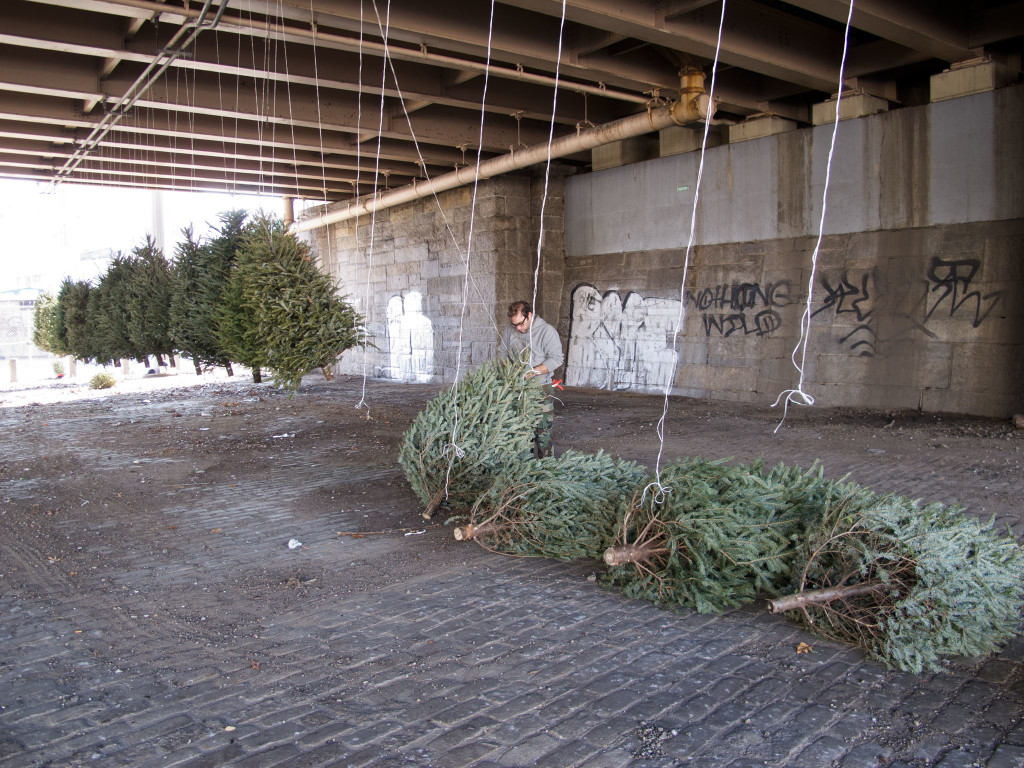
Suspended Forest 2013. Photo courtesy of the artist.
Michael installed the first Suspended Forest on New Year’s Day of 2012. Originally a small installation of four trees, over the course of a day Michael changed around the initial layout. While he eventually settled on a set up that worked and he was happy with, in the end, the first Suspended Forest did not get a lot of buzz.
“The first year that I did it, 2012, I woke up early on New Year’s Day, I went and dragged a few trees, just like a handful down to the space and had some twine in my apartment and hung them up. I hung up four of them and the four that I happened to grab were two medium size trees and two sort of smaller ones. I looked at them and I was like, oh I don’t like this, it was almost like a nuclear family with two large trees and two small. It’s so easy for humans to anthropomorphize things, it felt weird and I chose to hang them pretty far off the ground, it felt strange to me and I didn’t like it. So I left it and I came back the next day, I took down the small trees and I got my friend to come help me, and she and I went and collected a bunch of trees that were all sort of the same height as the larger trees and I just hung them up across the entire width of that space of the BQE. That felt like the first real iteration and it felt really good, I liked it and I took some photos and shared them on social media and it didn’t really get a ton of attention that year.”
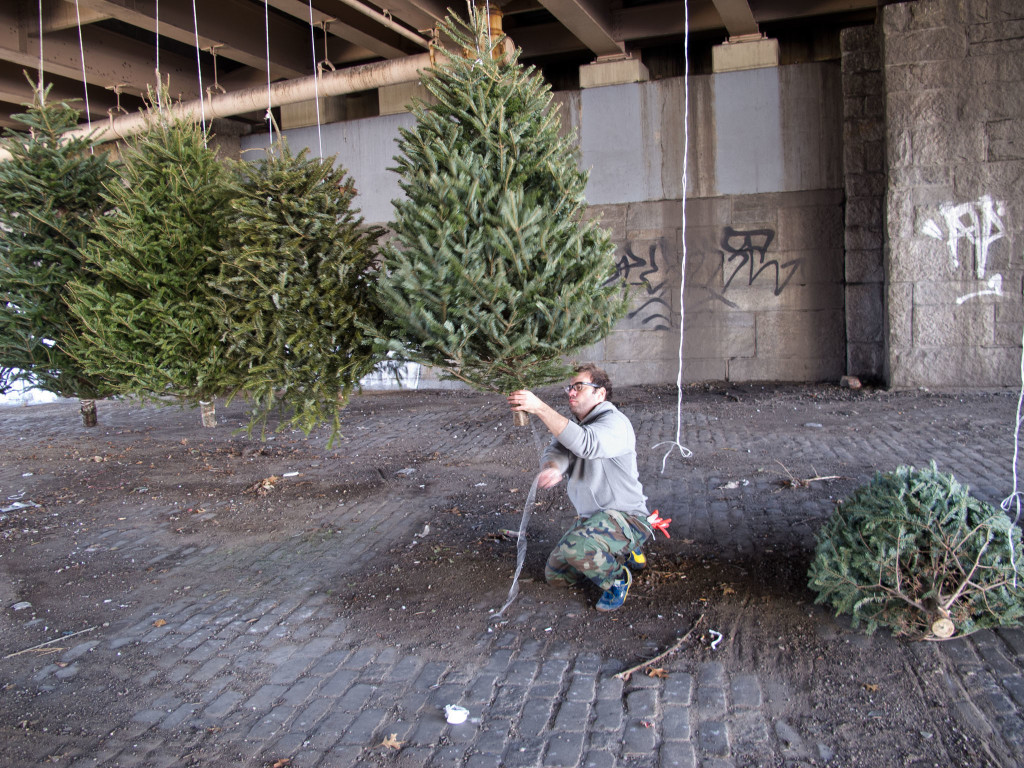
Suspended Forest 2013. Photo courtesy of the artist.
In 2013, Michael hung Suspended Forest again in the same section of the BQE, but this time he was more prepared: having a layout that he wanted to work with in mind, giving the project a name, setting up signs, and even creating a hashtag for it. He also reached out to some press.
“The next year, I got my girlfriend and my good friend who was the guy who I shared an apartment with in Williamsburg that first year, and they drove around and picked up trees and I just hung them up under the BQE. In 2013, I was really going for a wall of trees, I really wanted it to be tightly packed, and feel like a unit… I talked to people, people seemed to like it, and in 2013 more, there were more people I think because there were more trees, it was more interesting… One of the big differences in 2013 was I made a couple of small signs that had a drawing of a bunch of trees and a line above the trees, like simple triangle sketchy things, and just wrote Suspended Forest. I put a hashtag, #suspendedforest, on it and that was a big deal because that helped people sort of find it. A lot of people shared photos on Instagram, especially with the hashtag, but it lead to people finding it more, and I posted photos on Flickr and it lead to a bunch of press. I did a little bit of press emailing, it got picked up a little bit, and there was some press.”
That year also lead to a surprising encounter with the police, who gave Michael’s project a slight warning (if you can even call it that).
“Late in the installation process a police car actually stopped and they spoke to me and kind of just told me that I shouldn’t be there and there’s a gate on that space, and I was like, ‘the gate is open.’ And they said, ‘well ok, but this is private and you shouldn’t be here,’ and I was like, ‘ok, well I’m almost done,’ and they said, ‘well, ok, but you shouldn’t be here, I’ve told you that,’ and then they drove away. I finished installing the last few trees, I think there was only like three or four, and took a few photos and left.”

Suspended Forest 2013. Photo courtesy of the artist.
An observation that came from both the 2012 and 2013 installations was how the public sought permission from Michael before engaging with and photographing his project, highlighting the fact that sometimes people forget that works in public spaces are meant for public interaction and consumption.
“Both years, people talked to me about it and asked if it was ok to take photos, which I thought was really funny because I was doing this thing in a public space.”
This year’s iteration, since it is taking place in a gallery space and not under the BQE, saw more formalization and a stronger sense of planning. Michael was also able to get more help and the word out to a larger audience.
“This year, obviously it’s a different story because it’s in a sanctioned space, I had time to plan, a big difference between this year and previous years I got to send out a Facebook event invitation, which went crazy viral, that was a really distinct difference. I probably could have done something like that in 2013 or 2012, in 2013 maybe because I knew what I was doing and I was planning more, but that was a distinct difference this year. One of the other things that happened this year because I had all this planning to do I was able to get more help. So I had more people helping me this year, I had four people helping me install on Saturday and six people helping me install on Sunday, which was many more than previous years.”
Yet, while this year had indications that there would be a larger audience, it was during one tree-gathering excursion that Michael learned how impactful his initial two projects had been on some of the Brooklyn residents.
“Two of my friends were out collecting trees on Saturday and they ran into this woman in Greenpoint, where they were putting trees in the back of a pickup truck, and she said, ‘hey what are you guys doing?’ And this woman was older they said, probably in her 70’s, and they said, ‘oh we’re helping our friend, he’s doing this installation/sculpture with Christmas trees,’ and she said, ‘OH is it the one under the BQE? I LOVE that!’ Not a lot of 70 year-old women in Greenpoint go to galleries and museums, but at the same time she knew it. In 2012 it had only been up for six days, and in 2013 it was up for slightly longer but not long, not two weeks. So this woman had seen this thing and loved it in that time and years later, since it’s been three years since the last one went up, she still had this passion for it, I thought that was so cool.”
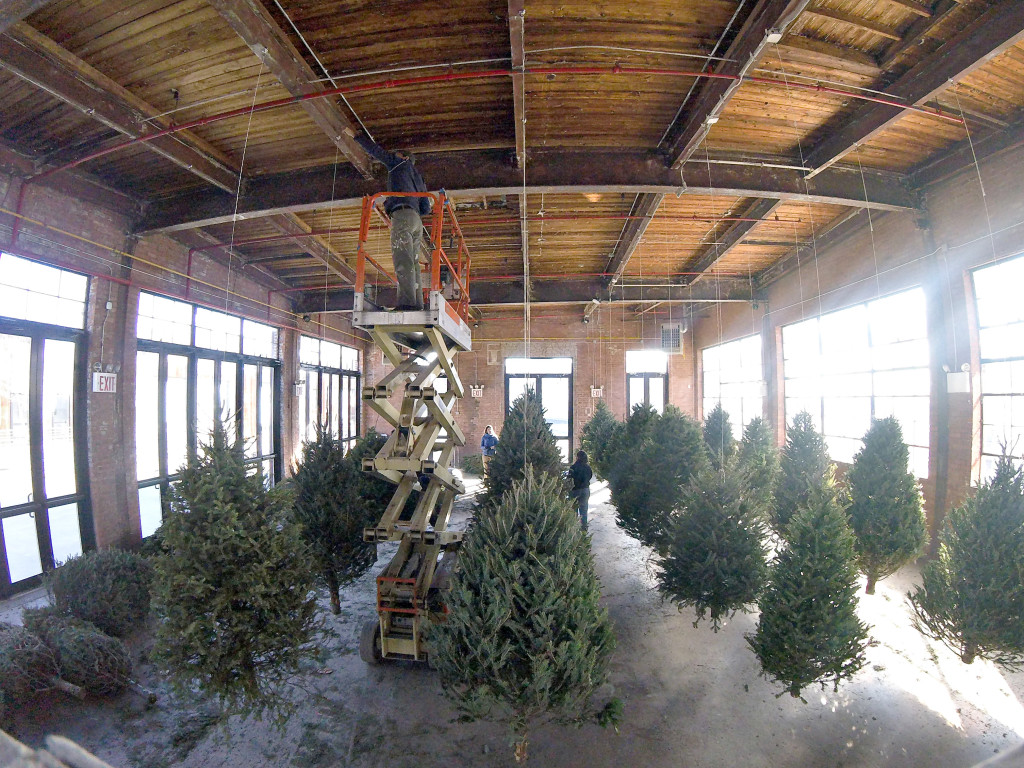
Suspended Forest 2016. Photo courtesy of the artist.
In terms of execution, part of what made this year’s project so captivating was the attention to detail that went into capturing and promoting every aspect of it, especially putting the initial installation process out through social media.
“So this year there was a lot more planning and preparation and things that could happen, again it was sort of more of what I wanted to do and I got a Go Pro and I shot I shot a time lapse of the installation process, and I think that might have helped the event invitation, maybe in its virality because people love those sorts of videos and they’re beautiful and easy to watch, easy to share. I have to go look but it got a lot of views on the event page. From a planning standpoint I had things like that that I could do, and the thing to about a space is that for the two previous times I did know how long it was going to be up, both times it was up for not much more than a week or not even a week.”
Another interesting aspect was that by transferring the project from a public to a more privately operated space it made it in a way more publically accessible, allowing visitors to engage more with it.
“I wanted a space where these things could spend some time, where people could come and engage with them without trespassing. I was interested in what that would be for people, being able to sort of do that, spend time and be close and clearly there was something there because people really activated this sculpture this year, this installation. People loved spinning the trees, it was a Mecca of selfies, there were so many selfies in front of the piece, people were lying under the trees and spinning them. Even though this wasn’t in the public sphere as much as the previous two installations, it still kind of connected with people in that same sort of way. I’m of the mind that when you do something like this, when you install something, you let it go, as soon as it’s installed it’s no longer your work anymore, it’s how the audience engages with it and it was so fun to watch the audience engage.”
A video posted by Michael Neff (@heyneff) on
The project even drew the attention of the BBC, who ran an article on it for their kid’s content section. This was an amusing anecdote for Michael because they had run one of his videos for it watermarked as his own. They also highlighted a new aspect to the project that couldn’t be experienced when it was under the BQE: the smell of pine emitted from the trees.
“Randomly, the BBC ran with this, they thought it would be fun for their kid’s content section, and it gave me such a tickle when I saw it because they had access to the video download file they had BBC watermarked my video! I was like, when’s that going to happen again in my life! I think that they took the angle of making Christmas last longer and it smelled good, which there is an olfactory component this year, you can actually smell it because it’s indoors and not under a stinky overpass.”
In only a short time (especially for having such a short shelf life), Michael’s project has had a strong following and impact on the public mentality. When asked why it seems his project had taken on a larger life outside of his initial expectations, Michael indicated that the simplicity of it in a sense gave it universality.
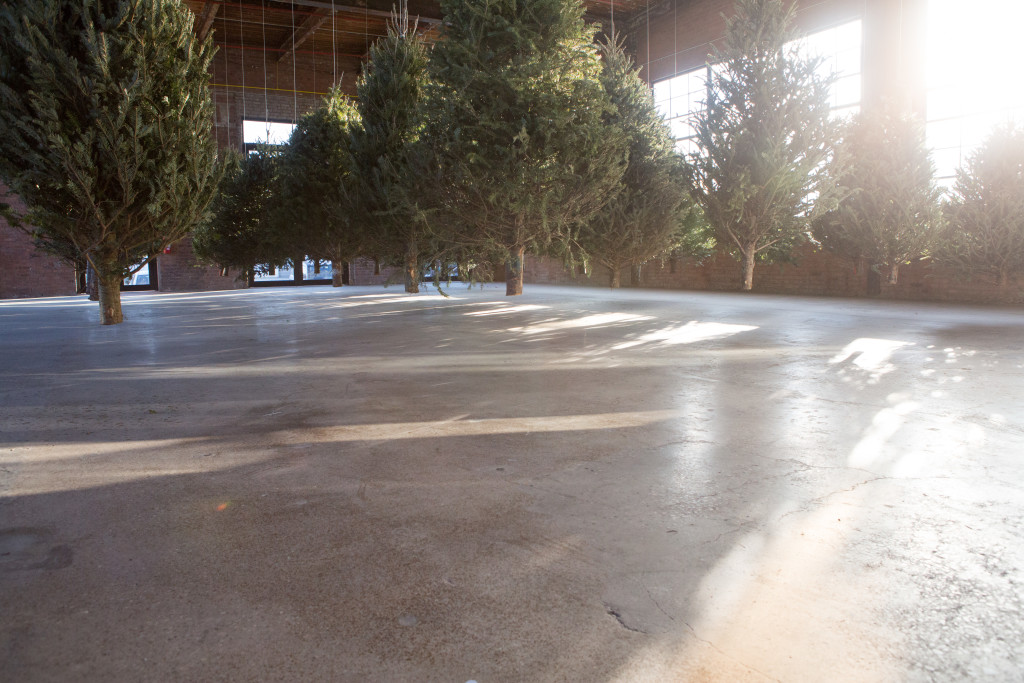
Suspended Forest 2016. Photo courtesy of the artist.
“I feel like that is kind of how these things work, you know. Not to belittle the project at all but it’s a pretty simple idea and I think that might be part of why it has kind of a universal appeal. You can very easily imagine it and hold it in your head, it’s almost like the old adage about modern art, where somebody sees a painting and they’re like, ‘my kid could have done that!’ But it’s like, ‘well yeah but your kid didn’t and you didn’t, I did it,’ and that’s the point, I brought this thing to reality.”
Teachers, artists, and other professionals have contacted Michael in the past by about the possibility of staging their own versions of his works, both in regards to Suspended Forest and other projects. While there is always the risk of appropriation, overall Michael is excited by the idea that something he created has brought happiness and awareness of ideas to new communities.
“It’s one of those things where you put the idea out in the world and, at a certain level, you can’t be too protective, you can’t be too territorial about it because sure, anyone could go do this, I’m not going to stop them. That’s cool, I love the idea that I create ideas that are interesting enough that somebody wants to take their time to go try and do it themselves, and if it brings them happiness, if it brings their community happiness, the way that my executions of them do, I think that’s a wonderful thing.”
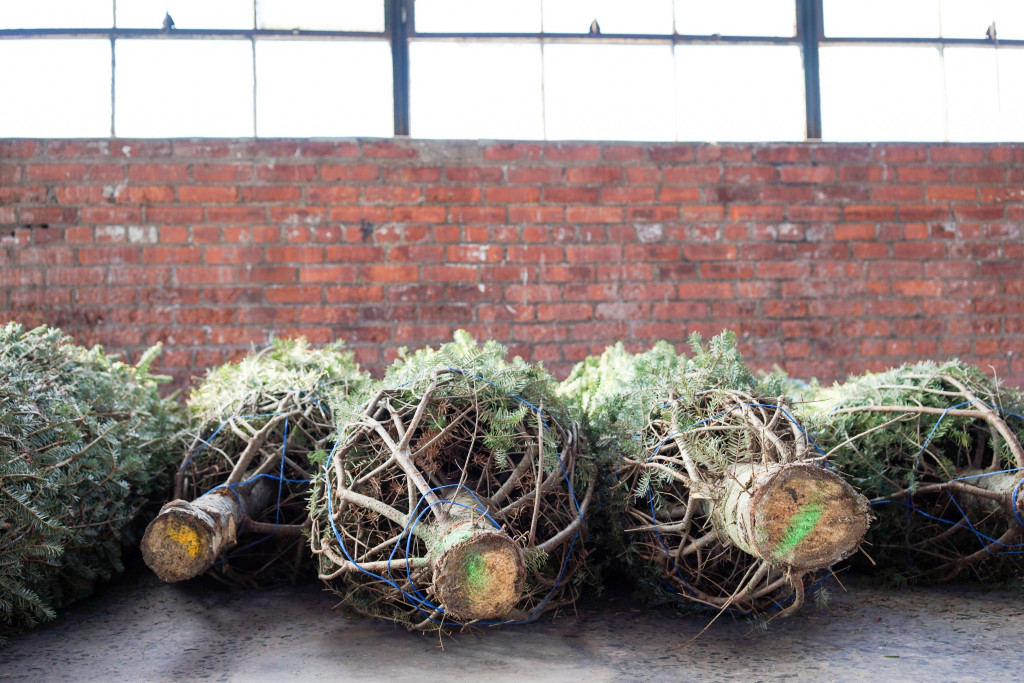
Suspended Forest 2016. Photo courtesy of the artist.
As for the future of Suspended Forest, Michael has not thought about whether or not he will be staging it again, but that possibility has been on the minds of everyone around him.
“It’s really funny, I didn’t talk about staging it again at all, but many people have already talked to me about staging it again. My wife was telling me, ‘I think what we should do every year is go to a different city and install it there, we can travel around and see different cities and install Suspended Forest.’ At the opening, a friend of mine, one of the guys who helped do a lot of the installation, he’s cofounder of a company that is making a camera and he came to the opening and his partner came to the opening and they were like, ‘yeah, so we’re already talking about how next year we need to shoot it with this camera because it would be so great.’ And I was like, ‘I love it, I’m not the person to talk about next year, everybody else is talking about next year.’ I don’t know, we’ll see.”
Suspended Forest will be on view at Knockdown Center in Maspeth until January 31, Saturdays and Sundays from 2-6pm and admission is free. In the meantime, check out the project on Instagram and Twitter (look for #suspendedforest), or feel free to email Michael at info@michaelneff.com.


One Trackback
[…] on Flushing Avenue. It may be billed as an art gallery, but it’s also been transformed into an indoor forest, and it once served as a stage for […]